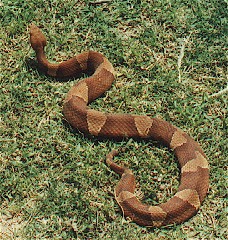|
AnimalsThe Appalachian trail winds through areas that have abundant wildlife. The area is a zoologists paradise. There are far too many mammals, birds, reptiles, and amphibians to catalog here and only a few are being listed. Despite the number and variety of animals that are found in the area a hiker will have to be patient and observant to see many of them. In fact days may go by with seeing few if any at all. Urban "wild" animals are used to close association with people and are practically domesticated. Such is not true with animals of the forest. In most instances the will either see, hear, or smell someone coming and run off before they can be spotted. People are amazed when they find that I don't carry a gun and want to know what I would do if I were attacked by a bear or rattlesnake. I reply that any gun I would be carrying would only irritate a bear if I shot it. Any larger gun would be too heavy to carry. As for rattlesnakes, they are easily avoided if they are seen and if I couldn't see one to avoid it I definitely wouldn't be able to see it to shoot it. The following lists some of the more common animals found along the Appalachian Trail. 
Field
Mouse - The field mouse is perhaps the most common animal found
along the Appalachian Trail. They sometimes become a nuisance. They've
been known to nest in boots, chew up clothes, and run right over sleeping
people in their quest for food. You may wake up one morning to find
that one or more had made a nest on your boots. Making sure your food
is safe from mice is an important chore before bed time

Black Bear- People who say that a bear can't climb trees should get a look at this fellow. It is perhaps the animal that people fear the most. While it is true that they are big with most weighing between 135 and 350 lbs they generally leave people alone. Perhaps they see us as another big animal that can do as much damage to them as they could do to us. Attacks on humans have occurred but are extremely rare. In most instances the bear was more interested in the food that the human was carrying and a battle was avoided by giving up the food bag and running off. Other attacks have come when the bear was startled or if a person walked between a female bear and her cubs. These latter attacks are avoided by making noise as you walk. Normal conversation or singing is sufficient to warn these bears off. If a bear is seen it is normally the rear end scurrying off into the woods.

Eastern
Spotted Skunk- These guys are smaller and faster than their
striped cousins .Unfortunately, they are not particularly afraid of
people and will sometimes wander into a cabin or picnic shelter. They
may even curl up next to you while you are sleeping. Please do not disturb.
 Porcupine- These critters are found mostly in the northern states. The porcupine feeds on leaves, twigs and green plants and has a ravenous appetite for salt (it will chew on any salt stained tools or clothes it comes across) and also it relishes plywood because of the glue between the layers. This appetite for salt makes them a frequent visitor to trail shelters where they attempt to eat boots, backpacks, and anything else that may have become soaked with perspiration. It is not recommended that you swat one if you see it.
These
are some of the more unusual mammals that are found. Of course there
are abundant squirrels, rabbits, raccoons, and dogs. Dogs
are a special and sad case. Many people tire of their pets and abandon
them in the woods. These domesticated animals never learned to hunt
for food. The lucky ones are adopted by hikers and are returned to civilization.
The fate of the others is unknown.These are some of the more unusual
mammals that are found. Of course there are abundant squirrels, rabbits,
raccoons, and dogs. Dogs are a special and sad case.
Many people tire of their pets and abandon them in the woods. These
domesticated animals never learned to hunt for food. The lucky ones
are adopted by hikers and are returned to civilization. The fate of
the others is unknown.
Moose-
Another animal found in the Northern stretches of the trail.
They are most likely to be spotted in Maine

Reptiles Many varieties of snakes are found along the Appalachian Trail. The 2 most often mentioned are the:

Both snakes are venomous (poisonous) snakes are best avoided. While serious, snake bites are uncommon and are seldom fatal to adult humans. Most occur because an inattentive person either stepped on the snake or tried to pick one up. These snakes venom is designed to kill the prey that it eats and it takes a while to make new venom once its supply is used. You are too big for a snake to eat and it does not want to waste its venom on you. If it did so, it may miss the opportunity for a meal.
There is one more mammal sometimes spotted although spottings are extremely rare. The Appalachian Trail crosses the Hudson River in New York. If one looks down river towards the bay and if one is lucky he or she may see one of these . Yes, Bottlenose Dolphins are sometimes seen from the Bear Mountain Bridge.

timber rattlesnake
and
copperhead
White
tailed Deer -Whitetail deer are extremely cautious and wary
animals with highly developed senses of sight, smell, and hearing. When
threatened with danger, they will often attempt to quietly sneak away.
If seriously frightened however, a whitetail deer will often utter a
loud, snorting or blowing sound, and then quickly run away while raising
the tail upwards like a flag, exposing the white underneath as a visual
alarm to other deer nearby.

|
